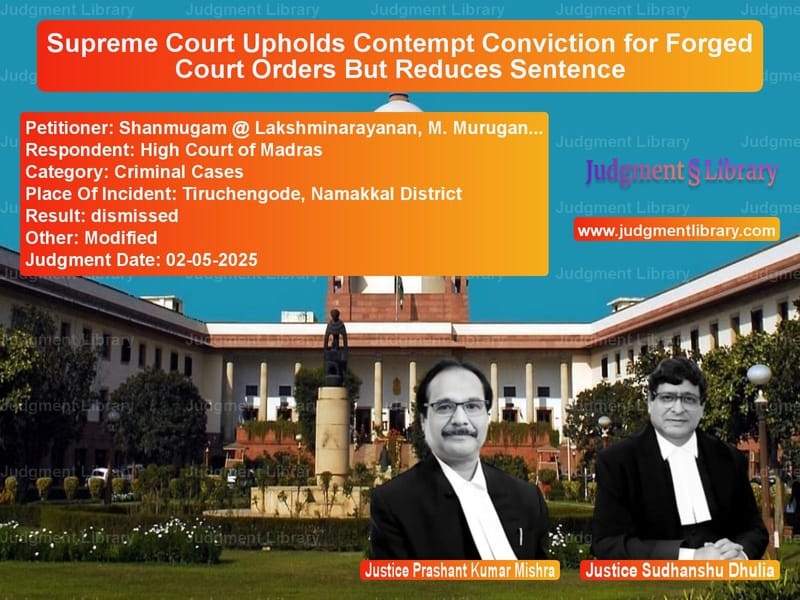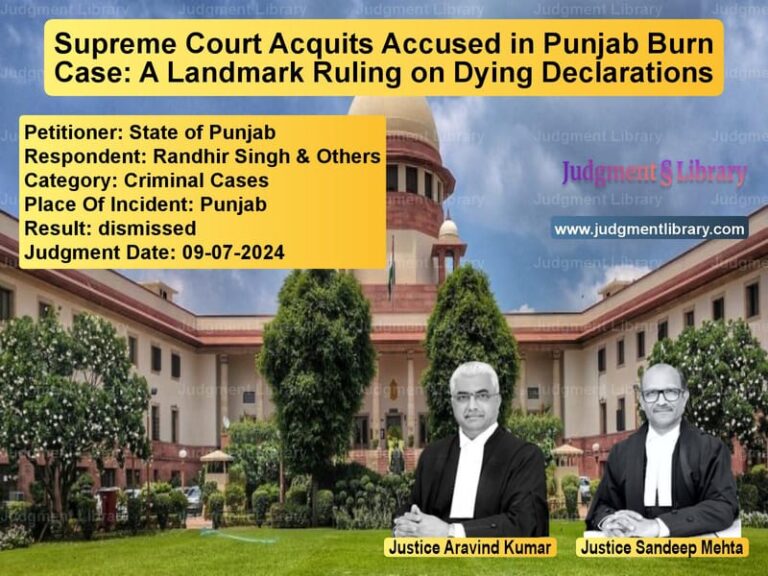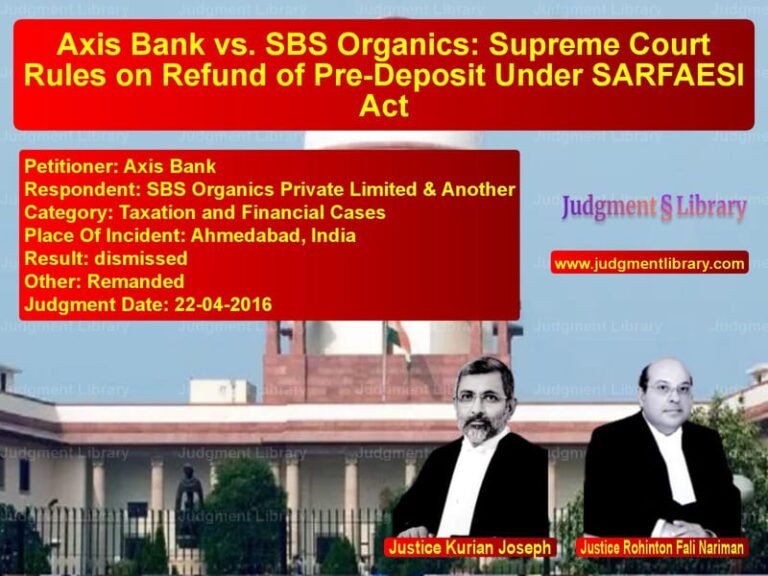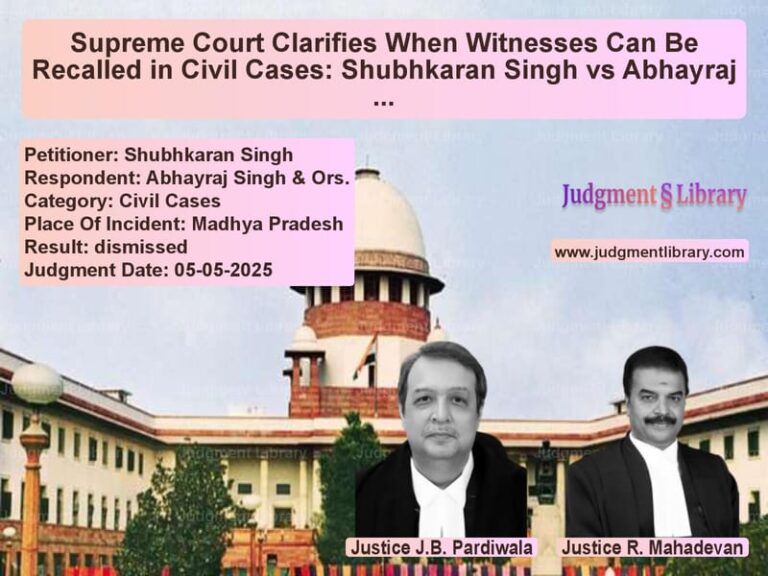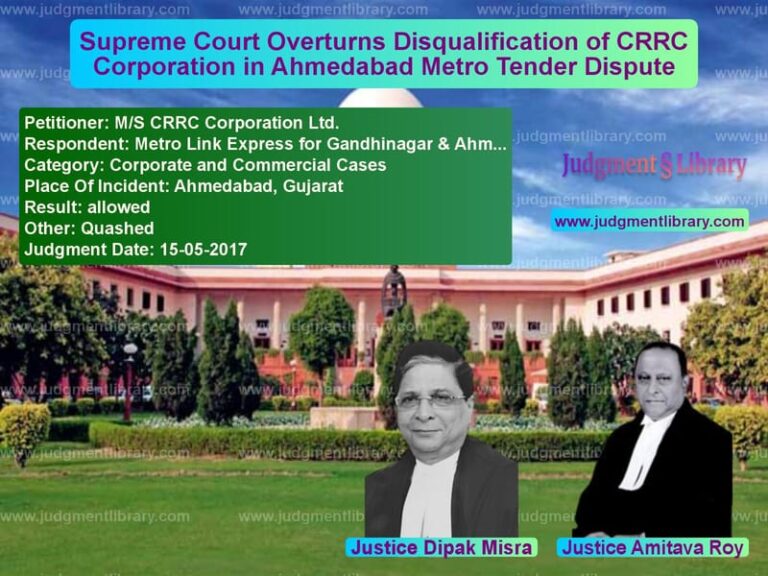Supreme Court Upholds Contempt Conviction for Forged Court Orders But Reduces Sentence
Imagine a scenario where a court bailiff arrives to execute a lawful order, only to be presented with what appears to be a genuine High Court stay order. The document looks authentic, bears what seems to be a judge’s signature, and carries the authority of the judiciary. But what if this document is a complete fabrication? This is precisely what unfolded in a case that recently reached the Supreme Court of India, testing the very foundations of judicial integrity and the consequences of forging court documents.
The story begins in Tiruchengode, where the District Munsiff Court had passed a decree in favor of J.K.K. Rangammal Charitable Trust in 2004, ordering recovery of possession and arrears of rent from certain individuals. These individuals, who would later become contemnors in the case, preferred appeal suits that were dismissed. When the Court Amin went to execute the decree to effect delivery of possession on April 17, 2018, the contemnors produced interim orders that appeared to be from the Madras High Court, staying the decree.
However, upon verification, a shocking truth emerged. These orders were fraudulently created through forgery and impersonation in the name of a High Court judge. The documents purported to be from Civil Revision Petitions that never existed, and the judge named had not been holding the CRP roster on the date mentioned. This discovery set in motion a legal battle that would ultimately reach the highest court of the land.
The Legal Battle Unfolds
The Decree Holder submitted complaints to both the High Court and the Superintendent of Police, leading to the registration of an FIR for offenses under Sections 466, 468 and 471 of the Indian Penal Code. The case took several twists and turns, including the mysterious disappearance of the case bundle from the High Court registry for about four years, which delayed the contempt proceedings until 2022 when the bundle was finally traced.
Three appellants—Shanmugam @ Lakshminarayanan (Contemnor No. 4), M. Muruganandam (Contemnor No. 3), and S. Amal Raj (Contemnor No. 7)—stood convicted by the High Court for committing contempt of court and had been sentenced to undergo simple imprisonment for six months. They approached the Supreme Court challenging the legality and validity of the High Court’s judgment.
The Arguments Presented
The appellants, represented by senior counsel Ms. Sonia Mathur and Mr. S. Nagamuthu, raised several crucial arguments. They contended that the initiation of contempt proceedings was barred by limitation under Section 20 of the Contempt of Courts Act, 1971, since the notice was issued after four years in 2022, while the fake orders were produced in 2018.
They also argued that formal charges were not properly framed against the appellants, and that the standard of proof in criminal contempt should be the same as required in criminal cases—proof beyond reasonable doubt. The appellants pointed out that since the High Court had given the benefit of doubt to Contemnor No. 6 and acquitted Contemnor No. 5, the same yardstick should have been applied to them.
On the other side, the counsel for the respondent/High Court and the Intervenor/Decree Holder supported the impugned order. They argued that when contempt proceedings are drawn suo motu by the High Court, the law of limitation does not apply in the same manner. They emphasized that there was sufficient material against the appellants, and this was not a case of conviction based on probabilities but on cogent evidence.
The Supreme Court’s Analysis
The Supreme Court bench comprising Justice Prashant Kumar Mishra and Justice Sudhanshu Dhulia delved deep into the material presented before them. The High Court had recorded findings of guilt based on the CBCID report and the affidavits filed by the appellants in response to statutory notices.
The evidence revealed a clear chain of events. Contemnor No. 3 (M. Muruganandam) admitted in his affidavit that he submitted the fake orders before the Court Amin. The investigation revealed that Contemnor No. 4 (Shanmugam) was responsible for handing over the orders, and Contemnor No. 7 (S. Amal Raj) had floated the idea of preparing the forged orders. Telephone conversations between the contemnors, statements recorded under Section 164 of CrPC, and recoveries from the Digital Net Centre where the fake orders were prepared all pointed to their involvement.
The Court made a significant observation about the nature of contempt jurisdiction: “The sole object of the Court wielding its power to punish for contempt is always for maintaining the purity of administration of justice. Nothing is more incumbent upon the courts of justice than to preserve their proceedings from being misrepresented, nor is there anything more pernicious when the order of the court is forged and produced to gain undue advantage.”
The Court further elaborated: “When a person is found to have utilised an order of a court which he or she knows to be incorrect for conferring benefit on persons who are not entitled to the same, the very utilisation of the fabricated order by the person concerned would be sufficient to hold him/her guilty of contempt, irrespective of the fact whether he or she himself or herself is the author of fabrication.”
The Limitation Question
One of the central issues in the case was whether the contempt proceedings were barred by limitation under Section 20 of the Contempt of Courts Act, which states that no court shall initiate any proceedings for contempt after the expiry of one year from the date on which the contempt is alleged to have been committed.
The appellants relied heavily on the decision in “Pallav Sheth vs. Custodian & Ors.” to argue that the proceedings were time-barred. However, the Supreme Court examined the timeline carefully and found that while the formal notice was issued in 2022, the proceedings were effectively initiated much earlier.
The Court noted that the Decree Holder had preferred WP No. 22410 of 2018 on August 20, 2018—just four months after the fake orders were produced. When this matter came before the learned Single Judge on September 5, 2018, the Court formed a prima facie opinion that criminal contempt had been committed and directed the registry to place the matter before the Division Bench dealing with criminal contempt matters.
The Supreme Court observed: “Thus, it is this date i.e. 05.09.2018 when the contempt proceedings were drawn by the High Court though actual notice was issued later on by the Division Bench in the year 2022.”
The Court referenced its earlier decision in “Pallav Sheth” where it had held: “Action for contempt is divisible into two categories, namely, that initiated suo motu by the court and that instituted otherwise than on the court’s own motion. The mode of initiation in each case would necessarily be different. While in the case of suo motu proceedings, it is the court itself which must initiate by issuing a notice, in the other cases initiation can only be by a party filing an application. In our opinion, therefore, the proper construction to be placed on Section 20 must be that action must be initiated, either by filing of an application or by the court issuing notice suo motu, within a period of one year from the date on which the contempt is alleged to have been committed.”
The Court also noted the peculiar circumstance of the case bundle going missing in the High Court registry for four years, observing that such a situation should not render the Court powerless to punish for contempt when the matter had been brought to its attention within the limitation period.
Procedure in Contempt Cases
The appellants had also challenged the procedure followed by the High Court, arguing that formal charges were not framed against them. The Supreme Court rejected this argument, relying on the precedent set in “Vinay Chandra Mishra” case.
The Court quoted: “The criminal contempt of court undoubtedly amounts to an offence but it is an offence sui generis and hence for such offence, the procedure adopted both under the common law and the statute law even in this country has always been summary. However, the fact that the process is summary does not mean that the procedural requirement, viz., that an opportunity of meeting the charge, is denied to the contemner. The degree of precision with which the charge may be stated depends upon the circumstances. So long as the gist of the specific allegations is made clear or otherwise the contemner is aware of the specific allegation, it is not always necessary to formulate the charge in a specific allegation.”
The Court emphasized that the summary procedure in contempt cases does not violate principles of natural justice, as the prosecution is not aimed at protecting the judge personally but protecting the administration of justice.
Standard of Proof
Addressing the argument about the standard of proof, the Court acknowledged that charges of contempt must be established beyond reasonable doubt. However, in this case, the Court found that the standard had been met.
The Court stated: “Despite observation by the High Court, we are of the view that present is a case where it is established beyond all reasonable doubt that the present appellants/contemnors have either used or created fake High Court interim orders. It is not a case of mere probability of commission of offence rather it is a proved case of commission of offence. Creating fake orders of the Court is one of the most dreaded acts of contempt of court. It not only thwarts the administration of justice, but it has inbuilt intention by committing forgery of record.”
The Constitutional Dimension
The judgment also touched upon the constitutional aspect of contempt jurisdiction. The Court referenced “Pritam Pal vs. High Court of Madhya Pradesh” where it was held that the contempt jurisdiction of the Supreme Court and High Courts, being Courts of Record under Articles 129 and 215 of the Constitution, cannot be restricted by ordinary legislation.
The Court quoted: “From the above judicial pronouncements of this Court, it is manifestly clear that the power of the Supreme Court and the High Court being the Courts of Record as embodied under Articles 129 and 215 respectively cannot be restricted and trammelled by any ordinary legislation including the provisions of the Contempt of Courts Act and their inherent power is elastic, unfettered and not subjected to any limit.”
Reduction of Sentence
While the Supreme Court affirmed the conviction of all three appellants, it showed judicial mercy in reducing their sentence. The Court observed: “However, insofar as imposition of sentence of simple imprisonment for six months is concerned, the same appears to be harsh, therefore, considering the facts and circumstances of the case, we are of the view that ends of justice would be served if the appellants are sentenced to undergo simple imprisonment for one month.”
The Court accordingly modified the sentence from six months to one month of simple imprisonment, while confirming the conviction. The appellants were directed to surrender before the Registrar of the High Court of Madras within 15 days to undergo the sentence.
Broader Implications
This judgment reinforces the seriousness with which Indian courts view attempts to undermine the judicial process through forgery of court documents. The creation and use of fake court orders strike at the very heart of the administration of justice, as they not only deceive individual parties but also erode public confidence in the judiciary.
The Court’s reasoning on the limitation issue provides important clarity on when contempt proceedings are deemed to have been initiated, particularly in cases where administrative delays occur within the court system itself. The judgment balances the need for timely action with the recognition that technicalities should not prevent courts from dealing with serious contemptuous conduct.
Furthermore, the reduction in sentence demonstrates the Court’s ability to temper justice with mercy, recognizing that while the offense was serious, a six-month imprisonment might be disproportionate in the circumstances.
This case serves as a stark warning to those who might consider manipulating court processes through forged documents. The judiciary’s power to punish for contempt remains a vital tool in preserving the integrity of the legal system, and as this judgment shows, the courts will not hesitate to use this power when necessary to protect the administration of justice from such egregious attacks.
The Supreme Court’s decision ultimately strikes a balance between upholding the authority and dignity of the judiciary while ensuring that the punishment imposed is proportionate to the offense committed. In doing so, it reaffirms the fundamental principle that the courts must remain vigilant guardians of the rule of law, capable of protecting themselves against attempts to undermine their authority through fraudulent means.
Petitioner Name: Shanmugam @ Lakshminarayanan, M. Muruganandam, S. Amal Raj.Respondent Name: High Court of Madras.Judgment By: Justice Prashant Kumar Mishra, Justice Sudhanshu Dhulia.Place Of Incident: Tiruchengode, Namakkal District.Judgment Date: 02-05-2025.Result: dismissed.
Don’t miss out on the full details! Download the complete judgment in PDF format below and gain valuable insights instantly!
Download Judgment: shanmugam-@-lakshmin-vs-high-court-of-madras-supreme-court-of-india-judgment-dated-02-05-2025.pdf
Directly Download Judgment: Directly download this Judgment
See all petitions in Fraud and Forgery
See all petitions in Contempt Of Court cases
See all petitions in Judgment by Prashant Kumar Mishra
See all petitions in Judgment by Sudhanshu Dhulia
See all petitions in dismissed
See all petitions in Modified
See all petitions in supreme court of India judgments May 2025
See all petitions in 2025 judgments
See all posts in Criminal Cases Category
See all allowed petitions in Criminal Cases Category
See all Dismissed petitions in Criminal Cases Category
See all partially allowed petitions in Criminal Cases Category

